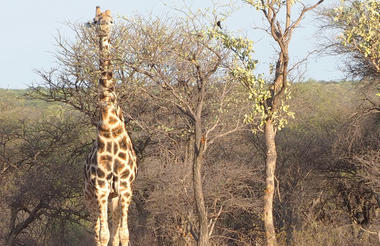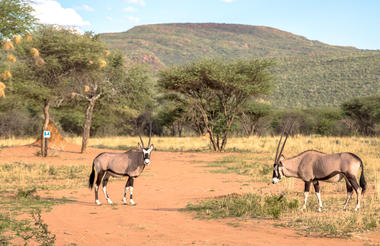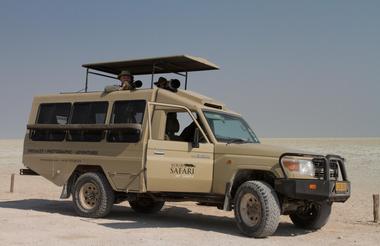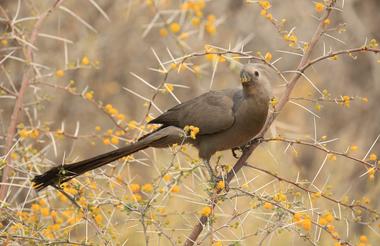You leave Etosha today and drive south down the main tar road until you get to the gates of Okonjima Nature Reserve for the first of 3 nights in this world renowned wildlife sanctuary.
We will arrive by lunchtime and will be able to relax in the magnificent rooms before going out on our first leopard tracking adventure
This Leopard “experience” takes you deep into the Okonjima Nature Reserve, where you’ll have the opportunity to spend extended time with Okonjima's experienced guides, focusing on finding the leopard. During this adventure, you’ll also become part of the research efforts, contributing to the ongoing leopard project and brown hyaena programme. Several adult leopards, accounting for approximately 40% to 43% of the 35+ leopards positively identified in the ONR, are fitted with radio collars.
These collars enable Okonjima's guides to monitor their movements using specialized telemetry devices. AfriCat has one of the longest-running leopard monitoring projects in Namibia. This significantly increases the likelihood of guests spotting these magnificent predators in their natural habitat during a one- or two-day visit to Okonjima. You’ll get to witness their captivating behaviour and interactions, especially when they compete for food. However, please keep in mind that even with these advantages, encounters with these wild, free-roaming predators can never be guaranteed



.
The presence of radio-collared leopards enables us to conduct long-term studies and ensures that future generations can continue learning from these remarkable creatures. It also offers our guests the chance to encounter them during brief visits. In a vast and arid environment like Namibia, characterized by acacia thickets and tall grass, leopard spotting becomes an even greater challenge. Unlike regions with higher rainfall or the expansive plains of East Africa, where territories are smaller, spotting these elusive big cats in Namibia can be incredibly challenging unless you have weeks or months to spend in the area, tracking them day after day.
Consequently, for those passionate about leopards and aiming to study the behaviour of these elusive creatures, we highly recommend a minimum 2-day stay.
Photographers should take note that capturing that perfect leopard picture, whether at Okonjima or any other location, requires impeccable timing and a deep understanding of leopard behavior. Learning to anticipate their movements and actions is essential for that perfect shot, and this level of understanding takes time and study – which is precisely why so many photographers and leopard enthusiasts, choose to visit Okonjima.
This morning we find ourselves on foot in the reserve walking with white rhino. During this trail, no telemetry device is used to track the rhino. Instead, Okonjima's knowledgeable guides and guests are joined by the reserve's dedicated anti-poaching units. These skilled teams have invested countless hours in getting to know each individual rhino, demonstrating their unwavering commitment to the conservation of these magnificent creatures within the Okonjima Nature Reserve.
After a hearty breakfast or lunch on your return you have time to relax around the lodge or enjoy birding around camp or enjoying one of several nature trails in the "safe zone" around the lodge before enjoying an evening meal and preparing to go out in search of pangolin
Participating in Pangolin tracking is a unique and specialized experience, and it’s important to note the following details:
The choice of going with a researcher or guide will be determined by circumstances, weather, and operational considerations.
Pangolin tracking is conducted both at night and during the late hours of the day, depending on the season. In the summer months (September- May), it generally occurs between 22:00 and 6:00 am, while in the winter months (June – August), it’s from 17:00 to 23:00 pm. These times align with the most active periods for these mostly, nocturnal animals.
Participation in Pangolin tracking is limited to a maximum of 6 people per trail. This allows you to gain valuable insight into the secretive life of the highly endangered Ground Pangolin.



Rhinos
Rhinoceros are critically endangered, with fewer than 30,000 rhinos living in the wild today.
Their dramatic decline is primarily due to illegal human activities. Historically, uncontrolled hunting during the colonial era played a significant role in the major decline of white rhinos.
Today, poaching for their horns poses the most significant threat. White rhinos, in particular, are vulnerable to poaching because they are relatively unaggressive and live in herds.
Participating in this trail provides a unique opportunity to appreciate the dedication of our anti-poaching teams in the ongoing battle for rhino conservation at Okonjima.
Pangolin
Okonjima Nature Reserve (ONR), home of the AfriCat Foundation, is also called home for a wide range of interesting species, one little known resident is a scaly anteater known as the Temminck’s ground pangolin (Smutsia temminckii) or ground pangolin. They are one of eight pangolin species worldwide and one of four pangolin species which occur on the African continent, all of which are classified as Vulnerable by the International Union for Conservation of Nature (IUCN). The other four species are found on the Asian continent, all of which are either classified as Endangered or Critically Endangered by the IUCN. These animals are predominantly nocturnal which makes studying them difficult, especially in areas with high concentrations of predators, this is why African pangolin species are highly under researched.
After a well-deserved lie in following your night time adventures with the pangolin you can enjoy a hearty late breakfast or early lunch or if you feel refreshed then you could enjoy a guided walk with one of the guides.
Exploring the African bush on foot enables you to enjoy the smaller creatures and signs and trails that the wildlife leave behind.
This evening you have a choice of leopard tracking or joining an Endangered Species Drive in search of some of Okonjima's more elusive animals



Guided Nature Walk
We highly recommend spending time hiking in nature with our guides on Okonjima to fully experience the smaller, less obvious wildlife and the stunning landscapes that makes the Okonjima Nature Reserve unique. Hiking in nature allows you to unplug from screens and technology, offering a break from constant digital connectivity, and is a holistic activity that nurtures both body and mind.
With the guidance of someone who knows Okonjima, you’ll gain deeper insights into the local ecosystem and learn about the Etjo Sandstone rock formations first hand. This immersive experience not only enhances your appreciation for nature, but also provides a rare opportunity to connect with the environment in a meaningful way, while spending quality time with your partner or family.
Endangered Species Drive
This extended game drive offers more time to appreciate and understand the Okonjima Nature Reserve as a self-contained, natural ecosystem, with a focus that goes beyond tracking the leopard.
Since the private nature reserve was primarily established for the conservation of some of our more vulnerable mammal species, it offers an improved opportunity to encounter these relatively rare animals. This game drive focuses on the elusive brown hyaena, bat-eared fox, rhino, and other rare, wildlife species. The Okonjima Nature Reserve is home to over 40 mammal species, both large and small, as well as a diverse representation of typical flora.
For your last morning at Okonjima you have a choice of either going in search of leopard in the 54,000 acre reserve or walking with rhino one more time before setting off back to the city and your final night in Namibia at the lovely Hotel Thule which sits high on a hill overlooking Windhoek.
Here we can enjoy our last Namibian dinner , al fresco on the terrace while hundreds of lights go on below us.



After breakfast, and depending on when you flight is our guide will return you to the airport in good time for your journey home or on to your next adventure





